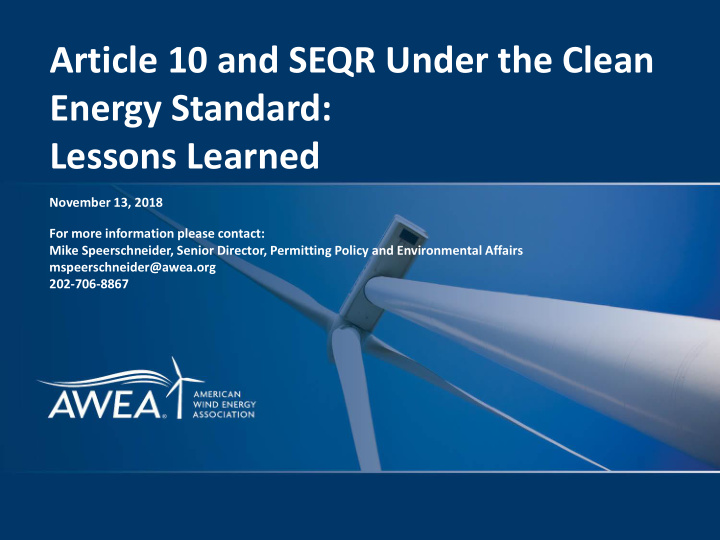



Article 10 and SEQR Under the Clean Energy Standard: Lessons Learned November 13, 2018 For more information please contact: Mike Speerschneider, Senior Director, Permitting Policy and Environmental Affairs mspeerschneider@awea.org 202-706-8867
Article 10: In a Nutshell? • “The a unified proceeding instead of requiring a developer or owner of such a facility to apply for numerous state and local permits.” • A previous version of the law expired in 2003. From 2003-2012, local governments reviewed projects under the State Environmental Quality Review Act. • Projects still need to work with local governments: • Road Agreements, PILOTs, Host Community Agreements • Local officials are able to sit as ad hoc members of the Siting Board. • “One of the primary reasons is the uncertainty related to permitting, particularly costs and timing. Also, permit conditions during construction and operations places higher costs and uncertainties on projects than projects on private land.” • Technical Review is completed by staff at DPS and DEC. • Hearings and disputes are adjudicated by a presiding examiner
Article 10 Potential for Success? • A unified proceeding, creating efficiency, certainty and consistency, is a huge opportunity. • 50% renewable energy by 2030 is a huge opportunity. • 40% reduction in greenhouse gas emissions by 2030 is a huge opportunity. • Solicitations for Large Scale Renewable Energy Certificates is a huge opportunity. • Article 10 process is a huge opportunity; • Public Involvement Program (PIP) to encourage more involvement from local communities • A ununified proceeding • Stipulations process to avoid lengthy hearing process • The ability to advocate for projects based on science-based, wholistic planning and siting, rather than single issues or emotional response.
Article 10 Actual Success? • 32 projects in Article 10 Queue • 4 Complete App and 1 other Submitted Apps • + 11 PSS submitted • + 17 PIPs submitted • Nearly all are renewables • More coming based on NYISO Queue • Total of 32 wind and 61 solar
Article 10 v. other states? Authority/ Standards Time Frame Process (from app) New York State authority, No - each case different. 3-4 years adjudicated hearings, State So far. Board decision Ohio State authority, Regulations include certain 1-2 years adjudicated hearings, State “standards” Board decision Precedents help applicants and speed the process. Pennsylvania Local authority, based on No – primarily precedent from ~1 year zoning laws. NPDES permit other jurisdictions. • Key Point: there is nothing to suggest any one approach is “better” than others. • There is no state or county that has more “problems” than others, so long as critical items are addressed: • Compatibility with land use • Environmental/species review
Article 10 v. other states? Contents of Article 10 Application (by Rule) Contents of Ohio PSB Application (by Rule) • • General Requirements Purpose and Scope • • Overview and Public Involvement Project Summary and Applicant Information • • Location of Facilities Project description in detail and project schedule detail • • Land Use Project area selection and site design • • Electric System Effects Electric grid interconnection • • Wind Power Facilities Economic impact and public interaction • • Electric System Production Modeling Compliance with air, water, solid waste and aviation regulations • • Alternatives Health and Safety, land use and ecological information • • Consistency with Energy Planning Objectives Wind farms • • Preliminary Design Drawings Construction, location, use, maintenance and change • • Construction Erosion control • • Real Property Aesthetic and recreational land use • • Cost of Facilities Wildlife • • Public Health and Safety Ice Throw • • Pollution Control Facilities Noise • • Air Emissions Blade shear • • Safety and Security Shadow flicker • • Noise and Vibrations Decommissioning • Cultural Resources • Geology, Seismology and Soils • Terrestrial Ecology and Wetlands • Water Resources and Aquatic Ecology • Visual Impacts • Effects on Transportation • Effects on Communication • Socioeconomic Effects • Environmental Justice • Site Restoration and Decommissioning • Local Laws and Ordinances • State Laws and Regulations • Other Applications and Filings. • Electrical Interconnection • Electric and Magnetic Fields • Water Interconnection • Wastewater Interconnection • Telecommunications Interconnection
AWEA Resources Reinventing the Wheel? • New website: www.awea.org • Fact Sheets • Publications • Under development: Issue Libraries • Regional Partners • ACE New York • Industry Positions and Standards
Recommend
More recommend